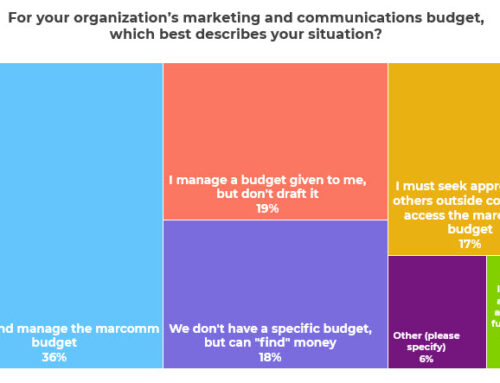
I’m teaching about editorial calendars a lot this month, and here’s one of the key lessons: Stay strategic while also making room for the unexpected.
You don’t know what’s going to happen in the future. But you do know that something is going to come up that you’ll have to deal with. So you need to accept that reality. Being Agile is the A in CALM.
Here are several ways you can stay agile and plan for the unexpected so that it doesn’t throw you off your game when it happens.
1. Follow My Editorial Calendar Rule of Thirds
When building an editorial calendar for the first time, I recommend using the rule of thirds: One-third of your calendar is filled with original or curated content, one-third is filled by repurposing the first third, and you leave the final third open for all of the stuff that comes up. For example, if you usually have three articles in a newsletter, you could plan two with strategic content and leave the third open until closer to publication time.
2. Spend More Time on Internal Communications
Many of the surprises that up-end a communications director’s day aren’t surprises at all to other people on staff. You just didn’t know about. If this happens a lot, it’s time to explore better collaboration and information sharing with your executive team or program staff — where ever those surprises seem to originate from.
This doesn’t necessarily mean you have to create another meeting. But maybe it means you are sitting in on an existing meeting. Or maybe it just means spending more time with your co-workers so you can check in more informally.
That can be tough when you don’t work in the same place. In that case, you should probably be using some kind of internal chat and/or project management software to aid in information sharing and quick updates.
3. Lead the Change on Communications Planning
If everything feels last minute and staff are constantly dropping things in your lap after the deadlines, that’s a cultural problem that will take time and leadership to change — and odds are that leadership will need to come from YOU. If you are constantly sucking it up and doing things at the last minute because of poor planning on the part of your co-workers, you are reinforcing their bad behavior.
You have to start somewhere, so pick a project far enough in the future that you aren’t working on it yet, but still within reason — say, your April newsletter for example. Create an ideal schedule and process for how that content should be created, reviewed and finalized. Talk with everyone about the value of this production schedule (how it will reduce stress for all staff and result in a better product for readers, for example). Then do it, and stick to it! If people miss their deadlines, publish anyway, using evergreen content if you have to, which takes us to our next point.
4. Have Solid Evergreen Content Stored Up
What if nothing comes up, or if your planned content falls through? Repurpose some timeless “evergreen” content. How-tos and lists are great formats for evergreen content.
5. Do Some Crisis Planning or Rehearse Less Dramatic Scenarios
Do you fear that your whole game plan could be destroyed by some crisis? You can manage that too, if you are prepared.
OK, maybe that’s a little too dramatic for you. But we could all stand to do some scenario planning. Think about five things that could go wrong in your work next week. How would you react? What’s your plan B? Even mulling these scenarios over during a short walk or coffee break will help you be more strategic when the real world gets in the way of your plans.
What are some ways you plan for the unexpected as a nonprofit communications pro? You can share in the comments (if you are reading via email, click over to comment on the blog).





